When Murdock Plumbing & Heating confronts clogs in inside lines, they grab their “one-two punch.” That’s what owner Robert “Bob” Murdock calls his arsenal of two hand-held drain cleaners from General Pipe Cleaners: the innovative Kinetic Water Ram® and Super-Vee® power drain cleaning machine. Experience matters. For nearly 45 years, his company has professionally served Read more
Industry Blogs
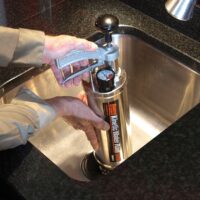
When Murdock Plumbing & Heating confronts clogs in inside lines, they grab their “one-two punch.”
That’s what owner Robert “Bob” Murdock calls his arsenal of two hand-held drain cleaners from General Pipe Cleaners: the innovative Kinetic Water Ram® and Super-Vee® power drain cleaning machine.
Experience matters. For nearly 45 years, his company has professionally served residential and commercial customers in the Elmira, NY area. They know Bob knows his job.
Proper tools count, too. “Drain cleaning is difficult,” he declares. “And you’ll never get very far without rugged, reliable equipment!”
Terrific Tag-Team Terminates Troubles
For decades, Bob has teamed both General tools in sequence to clear just most inside obstructions he finds. And he always starts with the Kinetic Water Ram.
Since the early 1970s, General’s pioneering drain cleaning tool has quickly cleared clogged lines with the power of kinetic energy. One long-time customer humorously dubs it “Bob’s Bazooka.”
Just pump it up, insert into a drain with standing water – and snap the trigger. It’s that fast.
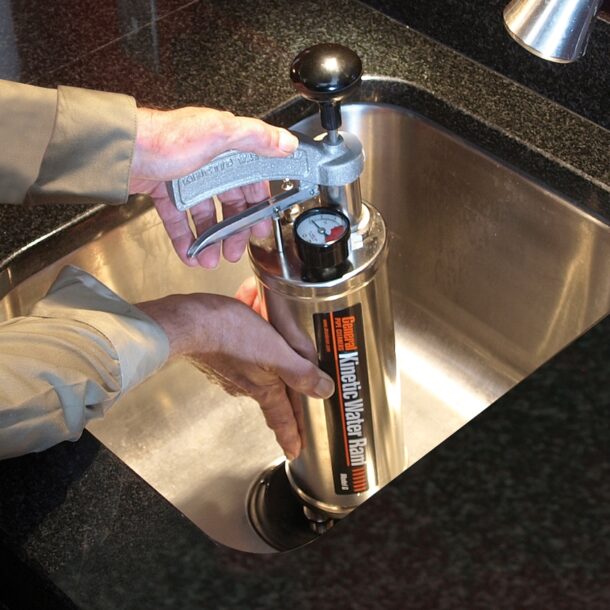
Fast & Eco-Friendly
Lightweight and economical, the futuristic Kinetic Water Ram generates a shock wave that instantly pulverizes stoppages in 1-1/4″ to 4″ lines – yet won’t harm pipes.
The shock wave bypasses vents and bends to batter blockages. And the tool’s built-in pump and pressure gauge lets operators choose the right amount of force for each job.
“Don’t over-pump it,” Bob quickly counsels. “We’ve found that 10 lbs. is usually enough to start with.”
Environmentally friendly, compact, portable Kinetic Water Ram is cleaner than snakes – and safer than chemicals.
Unlike some competitive devices, it requires no electrical power or CO2 gas. And it’s great for a range of plumbing, drain cleaning, maintenance, restoration, and rental applications.
Versatile & Safe
“It works great on 3/4″ air-conditioning condenser lines, too,” Bob injects. “And we don’t have to worry about electrical dangers!”
General’s sleek, plated Kinetic Water Ram also comes in a sturdy carrying case with molded compartments for the tool and accessories. A Schraeder valve for use with an external air compressor when clearing difficult blockages is also provided.
An optional toilet attachment screws onto the front of Kinetic Water Ram, turning it into a powerful plunger. The specially designed accessory precisely positions in bowls for a tight seal, hitting blockages with maximum impact – and no splash back.
His Innovative Alternative
But Bob’s somewhat old-fashioned. “I personally prefer our General Teletube® Flexicore® closet auger on toilet back-ups!” he winks.
The heavy-duty tool remains the industry’s most durable and versatile closet auger. General’s dual layer cable construction with a wire rope inner core can navigate nearly any toilet bowl – yet resists kinking and breaking and excels at clearing clogs just beyond the bowl.
Just push the button for three extra feet of Flexicore cable inside the guide tube. With a total reach of six feet, there’s usually no need to pull the toilet.
More Muscle on Tougher Troubles
If Kinetic Water Ram doesn’t pulverize the problem, Bob grabs his Super-Vee.
Easy-to-use, hand-held Super-Vee quickly unclogs sink, shower, toilet, and laundry lines up to 3″ in diameter. It’s so rugged that many last for decades without replacement. It’s that reliable.
General’s quick, convenient Slide-Action™ chuck engages and releases Flexicore cable by simply sliding the Super-Vee’s Grip-Shield forward or back – even while cable rotates.
The chuck also automatically adjusts to 1/4″ through 3/8″ diameter cables. And General’s quick-change cartridges let users easily switch or clean cables without delay or mess.
Industry-Leading Cable
Tightly wound over a wire rope core, then heat-treated, General’s legendary Flexicore design gives cables outstanding strength – without sacrificing flexibility.
And Flexicore is so tough, it carries a one-year warranty against breakage – the industry’s best.
A robust range of cables and cutters is available, too.
Powered by a variable speed motor, today’s Super-Vee carries up to 50 ft. of 1/4″ or 5/16″, or 35 ft. of 3/8″ Flexicore cable. Bob prefers 3/8″ cable.
And accessories include the novel Handy-Stand™ and Uni-Stand™ to facilitate working in cramped spots.
The Bottom Line
If neither the Kinetic Water Ram or Super-Vee works, it’s usually a pipe pitch problem, Bob says – necessitating line replacement.
“We can handle that, too,” he adds, shaking his head. “We’re finding lots of improperly installed drain lines.”
“Regardless, we’re going to stay on a clogged drain until it’s unplugged,” Bob Murdock vows. “And our General tools help assure that.”
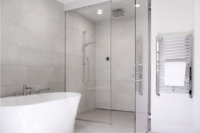
Are your customers requesting bathroom updates that will be stylish and functional for years to come? More homeowners than ever are renovating, using universal design principles that allow these spaces to serve people of varying ages and abilities. Universal design provides numerous important benefits to home and building owners, including higher levels of safety and Read more
Are your customers requesting bathroom updates that will be stylish and functional for years to come? More homeowners than ever are renovating, using universal design principles that allow these spaces to serve people of varying ages and abilities. Universal design provides numerous important benefits to home and building owners, including higher levels of safety and increased property value.
Universal design basics
Universal design creates an environment that is accessible to all people to the greatest extent possible. That means a bathroom will function as well for a child as it does for a senior. Basic principles of universal design focus on functionality. In the bathroom that might mean adding strategic lighting, slip-resistant flooring and features like grab bars.
Your customers don’t have to sacrifice aesthetics to achieve the functional goals of universal design. More options than ever are available for enhancing the bathroom’s safety and functionality while adding luxurious upgrades that are as useful as they are eye-catching.
When function and fashion blend like this in home improvements, it can add significant value to properties.
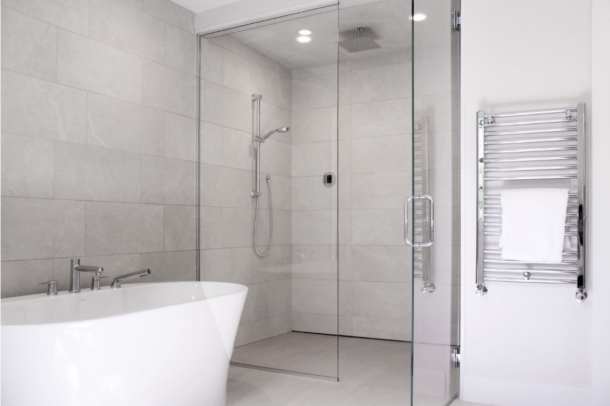
Curbless shower features
Consider one of the year’s top bathroom design trends: curbless showers with linear drains. This creates a barrier-free experience that is visually appealing, making it ideal for the universal design home.
A curbless walk-in shower eliminates hazards like curbs or thresholds that can cause people to slip or trip. It’s easier to use, whether you walk or utilize a device for assistance, such as a shower wheelchair. Curbless showers also provide an open feel, which makes the space feel larger because visual lines are not disrupted.
Curbless showers are enhanced by linear drains that are installed flush to the flooring, further reducing trip hazards while adding a sleek appearance to the space. With no barrier to cross, the floor more easily accommodates a freestanding bench, a walker or other mobility aids.
An added benefit is that linear drains generally avoid looking institutional, like some wheelchair-friendly bathrooms can. An excellent example of this counter-institutional trend is QuickDrain’s WallDrain, in which the drain literally disappears into the wall, offering an ultra-clean and contemporary look.
A curbless shower is achievable with various drainage points, therefore offering versatility in terms of design. A curbless shower also provides flexibility regarding its location, since you are not tied to placing the drain in a specific spot.
Deciding on shower doors is another important aspect of universal design. Glass doors work well for curbless walk-in showers because they open the space and let in light.
Another option is to design the space to be completely open as a wet room. Glass dividers are a hybrid option that provide a partition without a door, but can be easily removed if your customer might want to open the space in the future.
Shower bench
A shower bench can greatly enhance the look and functionality of a shower. It can serve as a necessary place to sit, a retreat to relaxation, or simply a place to store hygiene products, while also offering accessibility and style.
The QuickDrain BenchSeat offers three PET (polyethylene terephthalate) bench configurations to meet differing needs, depending on bench placement and overall shower size. These multiple configurations are suitable for newly constructed or renovated tile showers. Not only do these shower benches meet the ADA standard guidelines for height, but they also exceed the weight requirement, promoting a universal design for all.
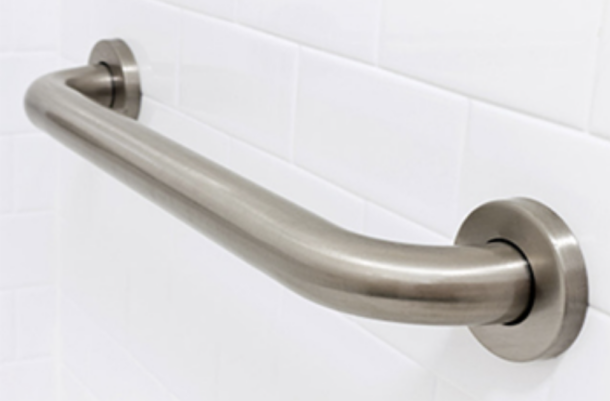
Grab bars
Grab bars will offer added stability and convenience to your shower and bathroom. Contrary to popular belief, grab bars aren’t just meant for healthcare or senior living facilities. They can also increase safety and convenience in your home for children, pregnant women, and anyone dealing with health issues or recovering from an injury.
Dearborn Grab Bars are ADA-compliant and available in 1-1/4″ and 1-1/2″ diameters with concealed or open flanges. Available in peened or satin finishes, these grab bars can be ordered in whatever length is needed.
Universal design is important in bathrooms because these spaces are used every day. Whether your customer’s goal is to age in place or to make home improvements to improve property value, bathrooms with stylish universal design will help you meet those goals.
 About the Author: Marlee Gannon is Director, Wholesale Product and Channel, at Oatey Co. With a robust background in sales, product development and marketing, Marlee’s comprehensive knowledge of the plumbing industry, its products and people, has helped propel her career over the past 7+ years. She is highly engaged with the chain of distribution, from end-users to Oatey’s wholesaler-partners.
About the Author: Marlee Gannon is Director, Wholesale Product and Channel, at Oatey Co. With a robust background in sales, product development and marketing, Marlee’s comprehensive knowledge of the plumbing industry, its products and people, has helped propel her career over the past 7+ years. She is highly engaged with the chain of distribution, from end-users to Oatey’s wholesaler-partners.
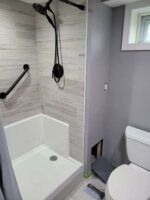
Home is where the heart is — and that’s exactly the motto many older Americans are beginning to live by. According to AgingInPlace.org, 77 percent of adults 50 and older want to remain in their homes for the long term, but one third of adults 50 years and older say they need to modify their Read more
Home is where the heart is — and that’s exactly the motto many older Americans are beginning to live by. According to AgingInPlace.org, 77 percent of adults 50 and older want to remain in their homes for the long term, but one third of adults 50 years and older say they need to modify their current homes for themselves or a loved one to do so.
The Pew Research Center reports the number of Americans living to be 85-and-over is on the rise, reaching an estimated 19 million by 2050. Because nearly one-third of elders residing in their own homes live alone, it only makes sense that houses are upgraded to assist individuals with aging in place.
With the increase in aging-in-place, universal design bathroom remodeling projects, you’ll want to position your firm to be the first plumbing professional a homeowner would call. One way to stay atop consumer referral lists is to stay on top of industry trends. That way, you will know which special features and products to suggest to a homeowner, depending upon their aging-in-place needs.
The remainder of this article will explore three projects ideal to create safe and worry-free environments for older Americans.
Slip-Resistant Floors
 Slip-resistant or non-slip flooring provides safer surroundings, even when wet. This type of flooring is a safe option for bathrooms, kitchens and laundry rooms — anywhere that water can be spilled or is not clearly visible.
Slip-resistant or non-slip flooring provides safer surroundings, even when wet. This type of flooring is a safe option for bathrooms, kitchens and laundry rooms — anywhere that water can be spilled or is not clearly visible.
Depending on your customer’s style preference and the degree of safety desired, slip-resistant flooring options range from vinyl to linoleum to rubber, and many more in between.
Bathroom Accessibility
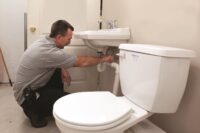 It doesn’t have to cost your customer an arm and a leg to add a new bathroom in a convenient place. By using affordable above-floor drain pumps and macerators, you can install a new bathroom and its drainage literally anywhere — in the garage or a reconstructed closet, even under a staircase — wherever your toilet and shower will be more easily accessible.
It doesn’t have to cost your customer an arm and a leg to add a new bathroom in a convenient place. By using affordable above-floor drain pumps and macerators, you can install a new bathroom and its drainage literally anywhere — in the garage or a reconstructed closet, even under a staircase — wherever your toilet and shower will be more easily accessible.
Products like the Saniaccess 3, a macerating pump system for installing a complete bathroom, can handle wastewater from multiple plumbing fixtures simultaneously; e.g., a toilet, sink, shower, and/or a bathtub.
Another innovative product to consider for half bathroom installations is the Sanicompact, a combination of a vitreous china toilet bowl and macerating flush system built into a single, compact fixture that will fit into even the tightest of spaces. Because it is a lower-profile toilet, this stylishly shaped product is specially designed to address the inconvenience brought on by disabilities or aging. The Sanicompacr is also ADA certified as a comfort height toilet.
Walk-In Showers
 When upgrading an existing bathroom, be sure to take measures to minimize the risk of falling. We have already mentioned slip-resistant floors. Another example is a walk-in shower that eliminates the need to take a step up into the space — and possibly tripping.
When upgrading an existing bathroom, be sure to take measures to minimize the risk of falling. We have already mentioned slip-resistant floors. Another example is a walk-in shower that eliminates the need to take a step up into the space — and possibly tripping.
If you are looking to add a new bathroom in an easily accessible location, consider a drain pump such as the Sanishower. An above-floor drain pump will allow you to add a shower without any major construction. This recent basement shower installation featured the Sanishower.
“It would take longer to drill the concrete floor and take the conventional route of replumbing the basement to support a shower,” said the contractor on the project, explaining the decision to install the Sanishower pump. “We needed the most efficient, least expensive way to build the shower in this half bathroom, which had only an existing toilet and a vanity sink.”
Convenience Within Reach
 Shower Accessories: More great aging-in-place conveniences in the shower stall or tub area include: (1) shower benches for resting, relaxing and even storage; as well as (2) strategically positioned grab bars. These accessories offer a practical, yet aesthetically pleasing addition to create a relaxed atmosphere. But attractively designed shower bars can also provide invaluable peace of mind when grabbing onto something solid suddenly becomes necessary.
Shower Accessories: More great aging-in-place conveniences in the shower stall or tub area include: (1) shower benches for resting, relaxing and even storage; as well as (2) strategically positioned grab bars. These accessories offer a practical, yet aesthetically pleasing addition to create a relaxed atmosphere. But attractively designed shower bars can also provide invaluable peace of mind when grabbing onto something solid suddenly becomes necessary.- Height Adjustments: Kitchens can also be modified to support the aging-in-place Lowering countertops and cabinets to a more convenient height can make mealtimes a breeze. No need to search for a stepping stool to reach items stored faraway: Everything can be right at the homeowner’s fingertips.
- Lever Taps: Replacing conventional cross-handle faucets with taps equipped with lever handles is yet another stylish, but practical upgrade for the home. Ideal for homeowners with joint or muscle stiffness, a simple flip of the lever will turn the water on or off, while another nudge to the right or left will adjust the temperature. You might even consider touchless faucets, a more hygienic alternative that offers even easier activation.
As more Americans embrace more active and longer lives, their homes and the amenities within them must keep pace as well. Taking proper steps to modify a customer’s surroundings, as they gracefully age in the comfort of their home, does not have to have an expensive process.
 About the author: Teresa Cardona is the Marketing Manager for plumbing manufacturer Saniflo SFA in Edison, NJ. She studied at the University of Hartford until 2019, holding a bachelor’s degree in Illustration and Design, and a minor in Communications and Marketing.
About the author: Teresa Cardona is the Marketing Manager for plumbing manufacturer Saniflo SFA in Edison, NJ. She studied at the University of Hartford until 2019, holding a bachelor’s degree in Illustration and Design, and a minor in Communications and Marketing.

Installing the right water filtration in industrial applications comes with a long list of benefits. A good filtration system helps lengthen the equipment life, cuts down the maintenance costs, creates a shield against hazardous chemicals, and lowers the effluent costs. It is how meticulously the water filtration process is planned and executed that makes or Read more
Installing the right water filtration in industrial applications comes with a long list of benefits. A good filtration system helps lengthen the equipment life, cuts down the maintenance costs, creates a shield against hazardous chemicals, and lowers the effluent costs.
It is how meticulously the water filtration process is planned and executed that makes or breaks the overall system. Anything could take a faulty turn when executing a filtration process. For instance, a wrong pump might cripple the filtration process, a seemingly harmless glitch during installation can cause irreversible filter damage, or an incorrect filter material can set the filter on a course towards pre-mature failure.
With a myriad of details and calculations involved, employing the right filtration solution for an application is no easy feat. However, becoming familiar with the most common (and frequently occurring) filtration mistakes can help ensure they’re avoided during the process.
This article discusses common pitfalls associated with selecting, installing, and using water filtration in industrial applications.

Getting the Sizing Wrong for Equipment and Filter Elements
As with everything, the planning stages are critical for installing and running a smooth filtration system. This is the stage that typically sees some of the costliest filtration mistakes – including the ones resulting from sizing issues
Faulty Filtration Equipment Sizing
When investing in filtration equipment, it’s paramount that the sizing aligns with what the application needs. The metric to consider when choosing the filter equipment is – the amount of liquid that the production would be running.
For instance, purchasing equipment that can push about 100 gallons a minute will not be of any use if a specific filtration step can only handle 10 gallons a minute. Not factoring in the flow rate during the process can negatively impact the production output.
Faulty Micron Rating
Filter specs can be customized as per the requirements of specific equipment. The customization options here typically include the core material, length, micron rating, diameter, filter media, and end cap configuration.
Among all the given options, micron rating is the trickiest to determine and has complete control over the filtration efficiency. If it’s too large, the contaminates can flow right through the filter. If it’s too small, the flow rate becomes obstructed.
A lot of research goes into finding the appropriate micron size. Most of it is associated with factors like the size and the consistency of the contaminants the equipment aims to filter.

Employing Incompatible Materials For Filter Elements
The core, the seals, and the filter media come together to form a fully-functional filter. For a filter to achieve an optimal outcome, each element needs to be compatible with the fluid’s temperature and chemistry.
The core can be seen as the backbone of a filter. When the core itself is incompatible with the fluid, it can give in to the water pressure and practically crush the filter. This unleashes the trapped contaminants into the downstream fluid.
The filter media is the shield that stands between the fluid and the contaminants. When the fluid temperature or chemicals react negatively with the media, it simply bloats and clogs – impeding the flow rate. The risk reaches its peak when the fluid chemicals are too aggressive for the media to handle, causing it to dissolve completely.
Sealing materials like an o-ring or a gasket practically guard the clean side of the filter from the contaminated side. When the seal itself is dysfunctional, the unfiltered fluid merges with the clean fluid resulting in a situation commonly known as “bypass”. When neglected long enough, these seals can either dissolve or erode – opening a passageway for the unclean fluids to flood in. A great approach to avoid filtration fiascos from filter elements would be to follow a chemical compatibility chart.
Performing A Flawed Installation
One of the common errors that can pop up during the installation process includes the reversal of the pipe housings (when the inlet and outlet housings get swapped).
Typically, filters can only handle fluid flow in a single direction (exceptions include filters that are made for backflushing). Unless the system requires liquid filter bags, the usual flow direction is always from the outside in.
Such an installation flaw can obstruct the flow rate and eventually knock down the filter. Most inlet and outlet pipes are labeled with the flow direction to help installation teams perform the task accurately. The filter equipment manual also comes with comprehensive instructions to maintain high accuracy during installation.

Selecting the Wrong Type of Pump
Pumps are what get the water flowing. In other words, they are the force behind driving the liquid through the filters. The outcome of a filter process depends on the type of pump employed in the system. It’s critical to ask the following questions when researching the right type of pump:
- What is the size of production runs?
- What is the viscosity of the liquid?
- What are the components within the process stream that may cause resistance to the flow rate?
- How far does the liquid travel?
Skipping the Air Venting Process
Once the filtration equipment is up and running, a critical step to remember would be to vent the air from the filter housings as the water seeps into them.
When ignored, the air trapped within the housing can form a bubble. This obstructs the liquid from filling up the housing completely. As a result, the overall flow rate declines.
Filter housings typically come with a built-in vent port or a vent valve that acts as the air’s escape route. To ensure the highest filter efficiency, the valve must be closed only when all the air leaves the housing.
Final Words
Even the smallest of “filtration glitches” can trigger irreversible damages down the line. As far as mistakes with water filtration are concerned, simply installing and running the process successfully is not the end of the task.
A filtration system demands regular maintenance to ensure the filter runs efficiently for a long time. A lack of maintenance can lead to clogged filters and loosened seals – degrading the quality of the final outcome.
Lastly, it’s critical to leave no doubt unaddressed when working with water filtration. In most cases, seeking the help of a professional is the best approach to getting everything “just right” and avoiding expensive losses down the line.
 Author Bio: Mark Ligon is the marketing manager at Commercial Filtration Supply. He oversees the development of business strategies and marketing of filtration products, including bag filters, cartridge filters, and strainers. Ligon writes about various liquid filtration applications to educate process and facility managers on best practices, ensuring they properly understand and care for their filter systems.
Author Bio: Mark Ligon is the marketing manager at Commercial Filtration Supply. He oversees the development of business strategies and marketing of filtration products, including bag filters, cartridge filters, and strainers. Ligon writes about various liquid filtration applications to educate process and facility managers on best practices, ensuring they properly understand and care for their filter systems.
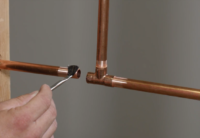
There’s a strong chance you’ve installed or spotted copper pipe somewhere in a home or building. Copper is the metal of choice for potable water systems for a variety of reasons – the most important being that it is non-toxic and safe for drinking. The naturally occurring metal element is also preferred for various application Read more
There’s a strong chance you’ve installed or spotted copper pipe somewhere in a home or building. Copper is the metal of choice for potable water systems for a variety of reasons – the most important being that it is non-toxic and safe for drinking. The naturally occurring metal element is also preferred for various application types due to its high conductivity of electricity and heat, corrosion/fire resistance and durability.
The process of joining copper pipe and fitting is called soldering (or sweating), which is a critical step in the copper installation process. Solder is a metal or metallic alloy that historically consisted of lead (known as lead-based solder) and tin in various proportions. Today, due to the Safe Water Drinking Act and lead-free restrictions, solders that contain more than 0.2% lead are not permitted for use in potable water systems.
Solders that are safe to use on potable water systems contain a percentage of tin and a combination of other non-toxic metals. The melting point of solder is lower than copper, and when heated, solder melts and fuses the piping together once completely cooled.
Learning how to solder copper pipe can seem daunting at first, but by applying proper techniques and avoiding typical errors, it becomes much easier to execute a leak-free pipe joint.
Let’s explore five common mistakes to avoid during the soldering process.
Choosing the Wrong Products
In addition to choosing the proper type of solder for your application, you will need to select the right type of copper pipe and flux, a compound that promotes the flow of molten solder between the pipe and fitting through a process known as capillary action.
Flux is also formulated to remove any oxidation from pipe and actually etches pipe surface in preparation for the soldering process to be successful. Important variables, such as ambient temperature, local code guidelines, and any jobsite time limitations, should all be considered prior to purchasing your soldering supplies.
Below, we’ve included some brief guidelines to keep in mind for your next soldering project.
- Copper Pipe
- Type K: Has the thickest wall and strongest durability. It is commonly used for commercial plumbing, such as underground water mains for potable water supply and HVAC lines.
- Type L: Wall thickness falls between Type K and M. Typically used for interior hot and cold-water distribution.
- Type M: Has the thinnest wall and is the most popular choice for domestic plumbing systems due to its light weight, decreased rigidity and affordability.
- Copper DWV: Commonly used in older homes for vents and drains. No longer a popular choice among modern-day homeowners, as there are more cost-effective options available.
- Flux
- Petroleum-based Flux (or Petrolatum Flux): Flushing required and designed to provide superior wetting properties for better solder flow. Compatible with all common plumbing solder alloys, such as copper, copper-coated metals, brass, zinc, galvanized iron, lead and tin.
- Hot Weather Flux: Specially formulated for hot weather climates and will not separate in temperatures up to 135°F.
- Water-soluble Flux: Water flushable and compatible with all common plumbing solder alloys.
- Tinning Flux: Available in both water-soluble and petroleum-based formulas. Enhanced with tinning powder particles to pre-tin piping and improve the flow of solder/enable even heating of a fitting, which is necessary when soldering larger diameter piping systems. Compatible with all common plumbing solder alloys. Check out this article to learn how to expertly solder low-lead brass using tinning flux.
Although petroleum-based fluxes are safe to use, they are required to be flushed with a chemical solution from the piping system due to their water insolubility. However, water-soluble fluxes become self-cleaning and flush away once water enters the system. Refer to manufacturer instructions for product-specific application and safety guidelines to ensure proper use.
- Solder
- Tin-antimony Solder: Contains 95% and 5% antimony. Lead-free and safe for water supply lines. Designed for use in plumbing applications where frequent extreme temperature changes and vibrations occur (refrigeration, cooling equipment and heat ducts); can also be used to solder electronics. Melting range is 450°F to 464°F. Has an unlimited shelf life.
- Copper-tin Solder: Contains 97% tin and 3% copper. Lead-free and safe for water supply lines. Designed for sweating copper and brass plumbing joints. Melting range is 440°F to 572°F. Has an unlimited shelf life.
- Silver-bearing solder: Contains silver, copper, bismuth and tin. Lead-free and safe for water supply lines. Ideal for low-lead brass applications. Has a wide melting range (420°F to 460°F) that enables more time for soldering joints.
Skipping the Prep
Failure to properly prep both the pipe and fitting is arguably one of the most critical mistakes in the soldering process. To achieve a properly sealed joint, oxidation and oils on the copper surfaces must be removed using special cleaning tools. Otherwise, it’s likely the solder will not completely fill the cup of the fitting, resulting in a weak or leaky joint.
Each of the following steps should be completed as you prep copper pipe for the perfect joint:
- After cutting the copper to the desired length, deburr (or ream) the inside of pipe end using a deburring tool to remove any small bumps or roughness (known as burrs) on the inside diameter or the pipe. If this step is overlooked, pipe pressure will decrease and water flow will be restricted. Any leftover burrs or copper shavings could cause noisy pipes when water enters the system.
- Remove oils and dirt from the outside of pipe end and polish clean with an abrasive sand cloth, open mesh cloth, nylon grit pad or tube cleaning brush. For wet applications, a nylon grit pad or open-mesh cloth are ideal due to their self-cleaning abilities.
- Clean all openings of the fitting hub with a fitting brush.
 Applying Too Much Flux
Applying Too Much Flux
It can be tempting to use a large glob of flux while soldering. However, we recommend evenly applying a thin layer of this product with an acid brush to copper pipe and the inside of a fitting – any excess flux should be removed prior to connecting them.
Applying too much flux will not only result in uselessly wasted product, but could also cause severe pipe damage over time. Once heat is applied to flux it turns to an acid; however, any excess flux will melt and travel through the inside of pipe, which may result in pitting and corrosion.

Overheating the Joint
When heating the fitting to sweat the copper pipe, make sure you remove the flame as soon the solder melts. As solder melts, flux will pull the solder into the fitting cup. Too much heat will cause excess solder flow or flux to burn out, which will increase the chance of a leak path.
Pro Tip: Never heat solder directly because you risk melting and breaking it off completely. It’s best to heat the joint evenly and then position the tip of the flame to the bottom of the fitting hub. The solder will flow toward the heat source and ensure the joint is completely filled.
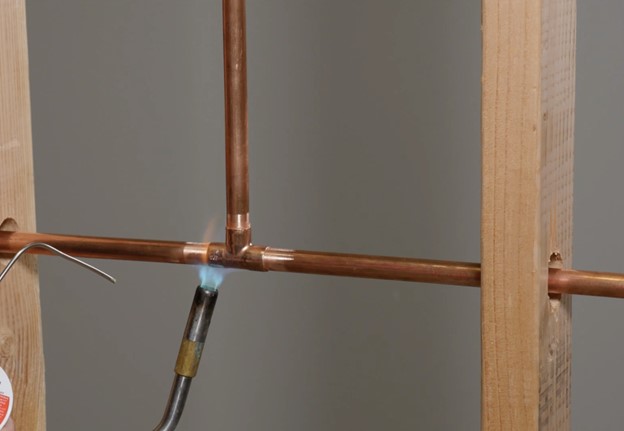
Neglecting Clean Up
While the joint is still warm, immediately wipe away any leftover flux or solder drips with a dry rag to ensure copper pipe longevity. Excess flux may seem harmless; however, it can cause Verdigris, a greenish-blue discoloration commonly found on copper, bronze and brass, to form and destroy copper pipe over time. An old, rusting penny and the Statue of Liberty are great examples of Verdigris in action.
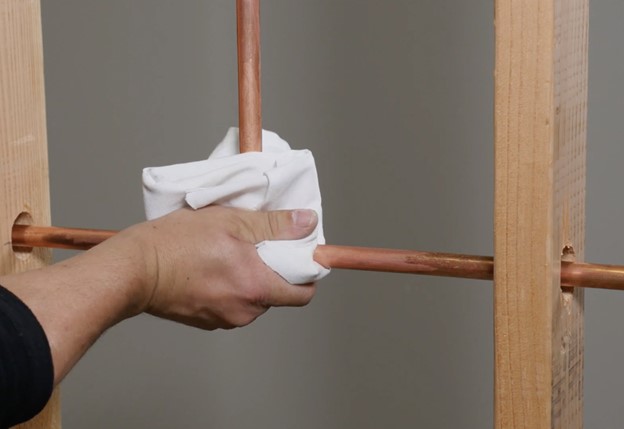
READY FOR YOUR NEXT SOLDERING PROJECT?
For a step-by-step guide on how to solder copper pipe, check out the video below.
 Author’s biography: Sean Comerford is a Technical Customer Service Specialist at Oatey Co. He is a third-generation tradesman with nearly 20 years of plumbing experience, including serving as the lead plumber for commercial/residential new construction, service and fire protection jobs. He holds a State of Ohio Fire Protection License for Sprinkler and Standpipe.
Author’s biography: Sean Comerford is a Technical Customer Service Specialist at Oatey Co. He is a third-generation tradesman with nearly 20 years of plumbing experience, including serving as the lead plumber for commercial/residential new construction, service and fire protection jobs. He holds a State of Ohio Fire Protection License for Sprinkler and Standpipe.


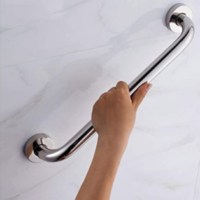 Shower Accessories: More great aging-in-place conveniences in the shower stall or tub area include: (1) shower benches for resting, relaxing and even storage; as well as (2) strategically positioned grab bars. These accessories offer a practical, yet aesthetically pleasing addition to create a relaxed atmosphere. But attractively designed shower bars can also provide invaluable peace of mind when grabbing onto something solid suddenly becomes necessary.
Shower Accessories: More great aging-in-place conveniences in the shower stall or tub area include: (1) shower benches for resting, relaxing and even storage; as well as (2) strategically positioned grab bars. These accessories offer a practical, yet aesthetically pleasing addition to create a relaxed atmosphere. But attractively designed shower bars can also provide invaluable peace of mind when grabbing onto something solid suddenly becomes necessary.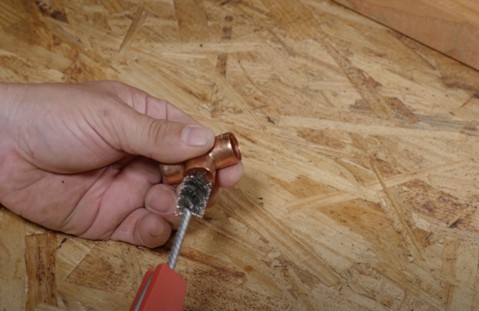 Applying Too Much Flux
Applying Too Much Flux